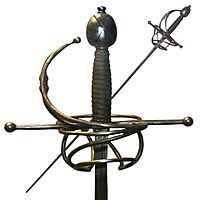Rapier facts for kids
Quick facts for kids Rapier / espada ropera |
|
|---|---|

Rapier, first half of the 17th century.
|
|
| Type | Sword |
| Place of origin | Spain |
| Production history | |
| Designed | around 1500 |
| Specifications | |
| Mass | avg. 1 kg (2.2 lb) |
| Blade length | avg. 104 cm (41 in) |
| Width | avg. 2.5 cm (0.98 in) to sharp point |
|
|
|
| Blade type | single or double edged, straight blade |
| Hilt type | complex, protective hilt |
A rapier is a type of sword that was very popular in Europe. It has a long, thin blade with a sharp point and often two sharp edges. People used rapiers a lot during the 1500s and 1600s.
Rapiers were used for different things. People carried them for self-defense or in duels. Soldiers also used them as a side arm alongside other weapons.
Contents
What is a Rapier?
A rapier is a special kind of sword. It is known for its long, narrow blade. This blade is usually straight and can have one or two sharp edges. The tip is very pointed, making it good for thrusting.
The handle, called the hilt, is often complex. It has special guards to protect the user's hand. These guards could be loops, rings, or a cup shape.
History of the Rapier
Rapiers became popular around the year 1500. They were used across Western Europe. This sword was a common sight for about 200 years.
It was a favorite for everyday use by civilians. It was also carried by soldiers. The rapier was designed to be quick and precise.
Fencing with Rapiers
Learning to use a rapier was an important skill. Many books were written about rapier fencing. These books taught people how to fight with the sword.
Italian Fencing Style
In Italy, there were famous fencing schools. They taught a style known as Bolognese swordsmanship. Teachers like Antonio Manciolino and Achille Marozzo wrote books about it in the 1530s. Later, in the early 1600s, writers like Salvator Fabris and Ridolfo Capo Ferro became very well known.
Spanish Fencing Style
In Spain, rapier fencing had its own style. It was called destreza, which means "dexterity" or "skill." This style was based on deep thinking and geometry.
A key figure was Jerónimo Sánchez de Carranza. He wrote an important book in 1569. It was about the philosophy of using weapons. Later, Girard Thibault wrote a famous book in French about this Spanish style in 1630.
From Rapier to Smallsword
The rapier's influence continued for many years. In the 1700s, a new sword appeared. It was called the French smallsword or court sword. This sword was smaller and lighter than the rapier.
The smallsword was mainly used for dueling. It carried on the tradition of rapier fencing. It was designed for quick, precise thrusts, just like the rapier.
Images for kids
-
Collection of early modern swords (17th to 18th centuries) at the George F. Harding Collection of Arms and Armor, the Art Institute of Chicago
See also
 In Spanish: Espada ropera para niños
In Spanish: Espada ropera para niños







